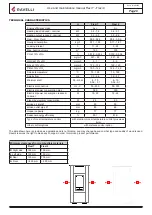
Use and maintenance manual S70 - S90 - SC90
Pag.19
Rev.0 18/05/2020
• use original parts recommended by the Manufacturer.
Forbidden actions
The user must never:
•
remove or change the safety devices without authorisation;
•
perform operations or manoeuvres of his/her own initiative that
are not part of his/her job description, meaning that he/she might
jeopardise his/her own safety and that of others;
•
use fuels other than pellet and those allowed for lighting;
•
use the stove as an incinerator;
•
use flammable or explosive substances near the stove during
operation;
•
use the stove with the door open and/or with the glass ruined or
broken;
•
close the combustion air and smoke outlet openings, whatsoever;
•
use the stove to dry laundry;
•
replace or change some of the stove parts.
Characteristics of the fuel
Wood pellet is a fuel made of pressed wood sawdust, often recovered from processing scraps of carpentries. The material used
cannot contain any extraneous substance such as, for example, glue, lacquer or synthetic substances.
The sawdust, once it has been dried and cleaned from impurities, is pressed using a die with holes: as a result of high pressure, the
sawdust heats up by activating the natural wood binders; this way the pellet maintains its shape even without adding artificial
substances.
Wood pellet density varies based on the type of wood and can exceed that of natural wood by 1.5 - 2 times.
The cylinders have a diameter of 6 mm and a variable length between 10 and 40 mm.
Their density is equal to approximately 650 kg/m3. Due to their low water content (< 10%) they have a high energy content.
The UNI EN ISO 17225-2:2014 standard (that replaces the EN PLUS standard) defines pellet quality by specifying three classes: A1,
A2 and B. Maintain fuels and other flammables at a suitable distance.
Ravelli recommends using wood pellet classified A1 and A2 according to the EN ISO 17225-2:2014 standard, or certified DIN PLUS
(more restrictive than the A1 class) or ONORM M 7135. Pellet may be light or dark coloured, it is normally bagged into bags that show
the name of the producer, the main characteristics and classification according to standards.
📌
Pellets must be transported and stored in a dry area. Upon contact with humidity they swell and become unusable:
📌
it is therefore necessary to protect them from humidity, both during transport and during storage.
Non-permitted fuels
We recommend not using the following materials as fuel:
•
wood
•
treated wood (painted, lacquered, glued wood etc.);
•
sawdust or chips
•
liquid fuel
•
coal or other fossil fuels
•
plastic and derivatives
•
treated paper and cardboard
•
waste
•
fuels that release toxic or polluting substances
Using these fuels, on top of being forbidden due to the emission of polluting and harmful substances, causes the stove to deteriorate
more rapidly and debris to accumulate in the stove and in the smoke evacuation system, thereby reducing performance and safety.
📌
The gases produced by these fuels are dangerous for the environment and for your health!
📌
Using fuel that is not compliant with the above will void the warranty.
Содержание Flexi 7
Страница 1: ...USE AND MAINTENANCE MANUAL Flexi 7 Flexi 9...
Страница 2: ......
















































